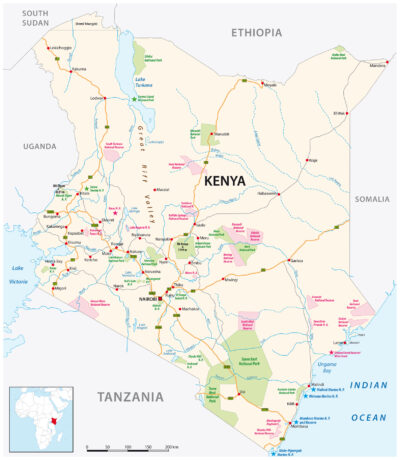August 10, 2023. Much of our work in the JFI Campaign focuses on the US/Mexico border and migration through Central America and the Caribbean. This is understandable given its geographic proximity and the visibility of the migration in the region. Nevertheless, it is important that we remember that migration is a global phenomenon that affects people on every continent. This summer we are blessed to have with us Janah Richardson, an intern from Princeton University, who spent time studying in Kenya. Below you can read some of her reflections on this experience and the ways in which migration impacts the surrounding region. Please reach out to Todd Scribner at TScribner@usccb.org if you have any questions or suggestions.
 August 10, 2023, Janah Richardson. This summer I traveled with Princeton university to Kisumu, Kenya, where I studied Kenyan history, government, and politics for six weeks. Each week we studied a different era of Kenyan history and analyzed Western involvement in the nation’s internal affairs. Western political and economic interest in Kenya since the colonial era has made Kenya the center of Western capitalism in East African. Although much of what I studied during the course about Kenya’s role in the region was in the context of geopolitics and U.S. counter-terrorism agenda in East Africa, through my internship at the USCCB, I have transitioned to studying the intersections of conflict in East Africa and forced migration.
August 10, 2023, Janah Richardson. This summer I traveled with Princeton university to Kisumu, Kenya, where I studied Kenyan history, government, and politics for six weeks. Each week we studied a different era of Kenyan history and analyzed Western involvement in the nation’s internal affairs. Western political and economic interest in Kenya since the colonial era has made Kenya the center of Western capitalism in East African. Although much of what I studied during the course about Kenya’s role in the region was in the context of geopolitics and U.S. counter-terrorism agenda in East Africa, through my internship at the USCCB, I have transitioned to studying the intersections of conflict in East Africa and forced migration.
Kenya is located within the Horn of Africa, a region of geopolitical, economic, and environmental importance. The region connects the East and the West and sits at the cross-roads of international trade. As such, the U.S. sees maintaining its historically good relations with Kenya as essential to ensure stability in the region. Kenya is also important in the context of global and regional migration. Kenya hosts over 300,000 refugees in its Dadaab camp, one of the largest refugee camps in the world. Dadaab, located in Kenya’s northeastern region, was established in 1991 by the U.N. as a temporary haven for refugees fleeing civil war in Somalia. Three decades later it is a sprawling complex with three camps. The ongoing conflict in Somalia and the worsening impacts of climate change in the Horn mean that more and more are arriving at Dadaab in search of relief.
 Kenya borders Somalia, a country that is experiencing significant humanitarian and political problems. Nearly half of the population is experiencing acute food insecurity. The country is the home base of the jihadist group al-Shabaab, which has engaged in an ongoing violent insurgency across central and southern parts of the country. Al-Shabaab attacks across the country threatens the security of Somali civilians.
Kenya borders Somalia, a country that is experiencing significant humanitarian and political problems. Nearly half of the population is experiencing acute food insecurity. The country is the home base of the jihadist group al-Shabaab, which has engaged in an ongoing violent insurgency across central and southern parts of the country. Al-Shabaab attacks across the country threatens the security of Somali civilians.
The broader Horn of Africa region is experiencing its most severe drought in four decades. The drought has been devastating to the region: crops have failed, livestock are starved, thousands have died, and widespread food and water insecurity are growing. The drought has been catastrophic for the many who rely on pastoralism to sustain their livelihoods. These compounded issues have forced thousands of Somalis to flee their homes for Kenya to find refuge and the opportunity for a better life.
Many of the people fleeing the region in recent years have left for Kenya and more specifically the refugee camp at Dadaab. The three camps that make up the Dadaab complex are feeling the strain of the influx of refugees fleeing the drought and famine. The camps are beyond their capacity. As the number of refugees swells, resources dwindle. The arrival of new refugees is exacting an extreme burden on the communities and refugees that are already within the camp. Many are settling on the outskirts of the camp with limited access to water, food, and other necessities. The recent cholera outbreak was a result of a reduction in clean water and sanitation and remains a point of concern for those working in the region. Dadaab is in urgent need of international aid and assistance to accommodate the inflow of refugees.
Many who arrive at Dadaab remain trapped there for years. The Kenyan government has imposed strict laws that prevent refugees from settling outside the camp. Many of the refugees were born in Dadaab and have no other home outside of the camp. Confined to life within the camp and forbidden to work, the prospect of resettlement dwindles, resulting in deteriorating mental health conditions for refugees in the camps. The situation in Dadaab needs long-term solutions. The protracted crisis within the camp can be resolved with opportunities to integrate refugees within Kenyan society. Education, vocational training, and financial services can help refugees become self-reliant in Kenya.
However, Dadaab also provides an example of the resilience and adaptation of refugees within Dadaab. It has become a de facto city, and an informal economy has emerged within Dadaab, demonstrating the entrepreneurial nature of Dadaab refugees. Because they unable to settle outside of the camps and integrate within Kenyan society, refugees have set up their own businesses, markets, and trades. Many who live within Dadaab earn a living by selling and services to refugees within or near the camps. These businesses are not internationally recognized, even though Dadaab is a booming business center. Viewing Dadaab through a negative lens would ignore the reality of the resilience and success of refugees and would underestimate all that they have to offer the rest of the world.
